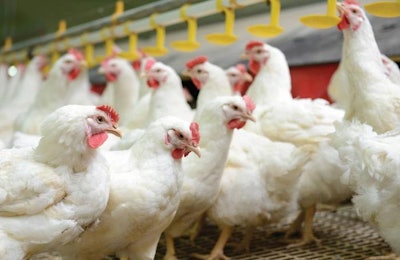
Seven key areas of live production for successful antibiotic-free poultry production were discussed by John Carey, Texas A&M University, in the webinar, “Antibiotic-free poultry production requires teamwork.”
In the webinar, presented by WATT Global Media and sponsored by Jones-Hamilton Company, Dr. Carey focused on live-production basics of high importance to antibiotic-free (ABF) poultry production.
1 Successful antibiotic-free (ABF) poultry production begins before the birds are on the farm.
The period between poultry flocks is the time for the grower to perform activities needed to get the next flock off to a good start. The following are especially important in ABF poultry production:
- Assess the need for poultry litter treatment and windrowing.
- Consider closing up the housing to induce heating and purging of poultry litter.
- Downtime of less than 14 days makes it difficult to accomplish everything that needs to be done to prepare for the first seven days of the chicks’ life, including preparation of satellite drinker and feed trays, placement of paper under drinkers and establishment of drinker water temperature.
- Heat poultry houses far enough in advance of the arrival of flocks for the litter to warm enough for the birds’ comfort.
2 ABF poultry production programs continue during poultry grow-out.
Attention to basic husbandry is a key to successful ABF poultry production. Growers need to spend “quality time” with the birds.
- Pay close attention to the birds in the flocks. Look, listen, smell and touch to evaluate a flock’s condition.
- Avoid overreliance on automated house management systems. Human husbandry is necessary to determine how the systems are performing for the flocks.
- Reducing stocking density can be beneficial in ABF poultry production.
- Basic husbandry is crucial. Provide for the feed, water and environmental needs of the needs of flocks without interruption.
- Litter quality plays an important role in coccidiosis control. Drinker management and ventilation are crucial to litter quality.
3 Reduce contamination and stress at the hatchery and during chick transport.
Avoid the dehydration, chilling and exposure to pathogens that can occur at the hatchery and during chick transport.
- Pull the hatch at the proper time.
- Minimize the time involved with chick holding and transport.
- Minimize stress during chick placement; everything should ready and in place for the chicks prior to their arrival on the farm.
- Proper sanitation of everything that the eggs and chicks come into contact with is critical.
4 Vaccination of breeder flocks and sanitation of fertile eggs are essential.
The husbandry provisions recommended for the grow-out operation apply to pullets, including implementation of a coccidiosis control program.
- Make sure that every hen is vaccinated so that the chicks have the immunity they need. Missed or skipped vaccinations cost in the future.
- Send only clean, uncontaminated eggs to the hatchery.
- Avoid exposing the fertile eggs to microbial challenges.
- Egg room hygiene is important, including workers’ hands and surfaces that the eggs contact.
- Maintain proper egg room temperature.
5 Feed milling and nutrition
Avoid feed milling- and nutrition-related stresses to antibiotic-free poultry flocks. It is imperative that feed inventory and feed delivery be managed closely. Never run out of feed on the farm.
- Larger particle sizes of feed benefit gut health and flock performance.
- Assure good pellet quality.
- Feeding all-vegetarian diets is the norm in ABF poultry production but the real key is in maintaining ingredient quality.
- There is a place in ABF poultry production for feed additives, but the key is to determine what is needed from the feed additive and under what conditions the additive can deliver the needed performance.
- Water supply and quality are an essential part of the nutrition experience.
6 Management and administration must adequately support ABF poultry production programs.
Poultry company management must ensure that the paradigm for antibiotic-free poultry production is followed throughout the live-production operation. There needs to be commitment of resources to support the changes necessary for a successful ABF program for poultry.
- There must be a "plan B" for birds that require antibiotic treatment; flocks needing antibiotic treatment must receive it.
- Communication and coordination within the live-production operation and externally are vital.
7 Veterinary care must ensure the ABF poultry flock’s gut health.
A main focus of veterinary care of ABF poultry flocks is on managing gut health.
- Vaccination of all breeder hens is essential for overall health of the flock.
- Coccidiosis control and gut health are of paramount importance.
- Flocks needing antibiotic treatment must receive it.
Dr. John Carey is a faculty member of the Department of Poultry Science at Texas A&M University, where he is engaged in undergraduate teaching and research in laying hen and broiler production.
View an archive of the webinar: https://goo.gl/o8z36p
Comprehensive resource for antibiotic-free poultry production available
A new collection of exclusive articles, blogs, infographics and videos on antibiotic-free poultry production, by trusted WATT Global Media editors and industry experts, equip poultry producers and marketers with information to help them make critical business decisions. Purchase your copy.


















